From the Golden Age to the Digital Age: Modelling and Monitoring Historic Tapestries
There are many rich collections of tapestries on display in museums and historic houses. Their construction using the finest materials of their day and their exposure to many years of light, pollution and handling means tapestries are often in need of extensive conservation treatment.
Our study employed both computational modelling and strain monitoring using digital image correlation. These two techniques have given us a greater understanding of the effects of commonly used conservation stitching methods on the tapestry structure, and have given us insights into the practice of displaying tapestries on slanted supports, a technique which has become increasingly popular in mainland Europe.
This research was funded by The Leverhulme Trust and ran for four years from 2016 to 2020 as a collaboration between the Kelvin Centre for Conservation and Cultural Heritage Research (known previously as the Centre for Textile Conservation and Technical Art History) and the James Watt School of Engineering.
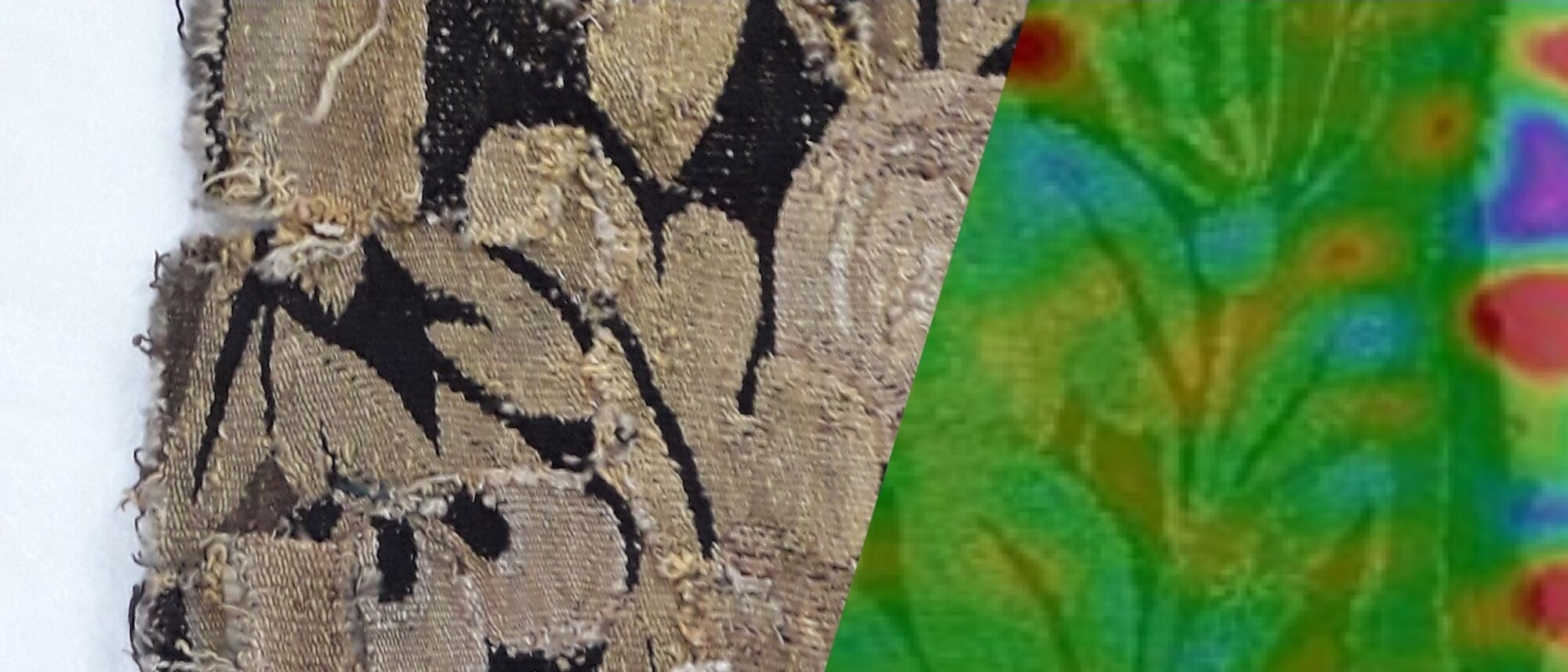
Using engineering techniques to investigate conservation and display techniques for tapestries
Project Team
- Professor Frances Lennard, Centre for Textile Conservation and Technical Art History - Principal Investigator
- Dr Philip Harrison, James Watt School of Engineering - Co-Investigator
- Dr Jafar Alsayednoor - Post-doctoral Researcher based in the James Watt School of Engineering (2016-2018)
- Dr Kenneth Nwanoro - Post-doctoral Researcher based in the James Watt School of Engineering (2019)
- Rosa Costantini - PhD Student based in the Centre for Textile Conservation and Technical Art History (2017-2021)
Research Themes
Strain Monitoring
An earlier collaboration between the Textile Conservation Centre and the School of Engineering Sciences at the University of Southampton for the AHRC-funded project: Towards In Situ Monitoring of Tapestry Degradation Using Strain Based Engineering Techniques trialled strain monitoring – specifically digital image correlation (DIC) - to assess the condition of historic tapestries. It found that this technique provided information on tapestry behaviour that could inform decisions about conservation treatments as outlined in the project report for this previous work.
Our project at the University of Glasgow has built on and taken this work further. We employed DIC as a tool to investigate tapestry conservation methods and to look more closely at displaying tapestries on slanted supports.
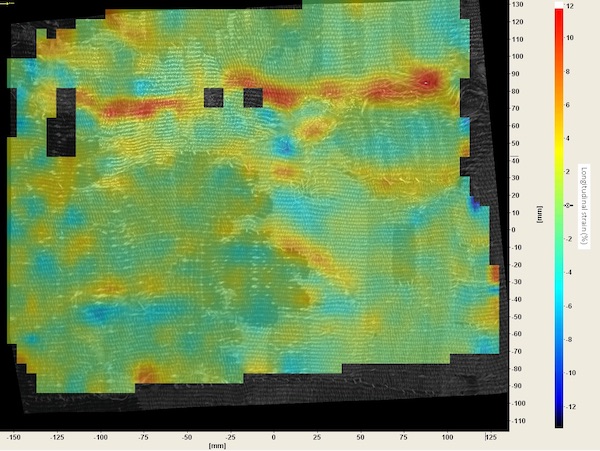
3D DIC is a non-contact monitoring method – this is important for historic artefacts. It takes simultaneous images with two cameras to provide information on out-of-plane deformation. It then compares successive pairs of images over time to measure displacement within the tapestry. Computer software translates this into strain, a measure of percentage deformation.
DIC gives quantitative and visual information on strain in tapestries. As well as strain measurements, the software also produces strain maps of areas of high and low strain which can help tapestry conservators and scientists to understand the effects of treatment on the tapestry overall.
Computational Modelling
One project aim was to create a rigorous digital model of a tapestry system using the latest research developments in finite element analysis (FEA) and software development, as a tool for investigating conservation treatment plans and display options. Modelling was employed as a way of validating the ability of the DIC technique to measure full-field strains across historic tapestries.
Tapestries are extremely complex structures, employing different materials - wool and silk yarns - in the warp and weft and a discontinuous weaving technique which creates ‘slits’ which are closed by stitching. The degradation and damage caused by centuries of use creates additional complexity. It was not possible to create a completely accurate model of a tapestry using FEA as this would be an extremely time-consuming task, but we were able to automatically create a bespoke full-field synthetic strain field based on a photograph of the tapestry, that bears a probable relation to reality, including likely sites of strain and damage.
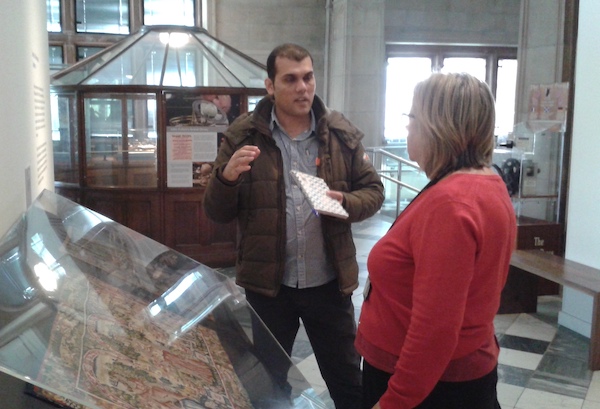
Using a digital image of a 15th-century tapestry from the Burrell Collection, Two Episodes from a Chivalric Romance, Perhaps the Tale of Florence of Rome, as an example, a representative model of the tapestry was created by mapping the tapestry details onto a finite element mesh. Layers of complexity were successively added to the model. Firstly, the Matlab Canny edge detection algorithm was used to identify joins in the weaving which create natural points of weakness (albeit simplified here). Secondly, areas of damage were artificially created by deleting the elements in five of these areas. Thirdly, conservation patches were modelled in these areas by adding larger ‘patches’ of a stiffer material.
The models gave inherent information on the effect of these areas of damage and the conservation interventions on the surrounding tapestry. More importantly here, the strain field generated by the simulation was used as a test case to evaluate the measurement error produced by DIC when using the tapestry image to track displacements. We wanted to establish whether the tapestry image itself (rather than the standard, applied, speckle pattern used routinely with DIC) would give accurate DIC results. DIC data were compared with the known deformations from the FEA model.
This technique demonstrated that the optimum imaging settings and the choice of subset size for DIC are strongly influenced by the tapestry image. Images with sharp colour contrasts or large homogenous areas will result in less reliable DIC data. It also demonstrated that selecting the optimum subset size depends on a trade-off between measurement accuracy and maximising resolution. For more information see our paper evaluating the use of DIC.
As a result of this investigation, tools have been produced which allow the assessment of a tapestry for its suitability for interrogation with DIC. Three factors affecting the quality of DIC results have been investigated in more depth: the suitability of the tapestry image, the image acquisition process such as the camera settings and lighting conditions, and the DIC settings. For more information see our paper investigating the accuracy of DIC.
Read more
- Alsayednoor, J., Harrison, P., Dobbie, M., Costantini, R. and Lennard, F. (2019) Evaluating the use of digital image correlation for strain measurement in historic tapestries using representative deformation fields. Strain, 55(2), e12308. (doi: 10.1111/str.12308)
- Alsayednoor, J., Lennard, F., Yu, W.R. and Harrison, P. (2017) Influence of specimen pre-shear and wrinkling on the accuracy of uniaxial bias extension test results. Composites Part A: Applied Science and Manufacturing, 101, pp. 81-97. (doi: 10.1016/j.compositesa.2017.06.006)
- Nwanoro, K., Harrison, P. and Lennard, F. (2022) Investigating the accuracy of digital image correlation in monitoring strain fields across historical tapestries. Strain, 58(1), e12401 (doi: 10.1111/str.12401)
2D DIC and Monitoring at Stirling Castle
DIC is customarily used to examine structures in 3D mode, using two cameras to give information on out-of-plane deformation. However the equipment for this is expensive and is difficult to site unobtrusively in a historic house or museum environment.
We trialled the use of 2D DIC, using a single camera, for monitoring historic tapestries. We found that a single camera can be used successfully, providing accurate strain data, if the tapestry hangs flat against a wall or support. But if the tapestry surface undulates, as is often the case with historic tapestries, it is necessary to use two cameras in a 3D system to register the out of plane deformation and calculate the strain.
A long-term trial was carried out on a newly woven tapestry, The Mystic Hunt of the Unicorn, at Stirling Castle, in collaboration with Historic Environment Scotland. A time-lapse camera was installed to capture an image of the tapestry once every hour over a five-year period from 2015.
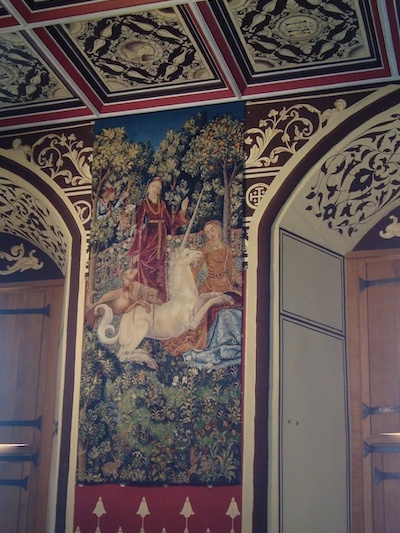
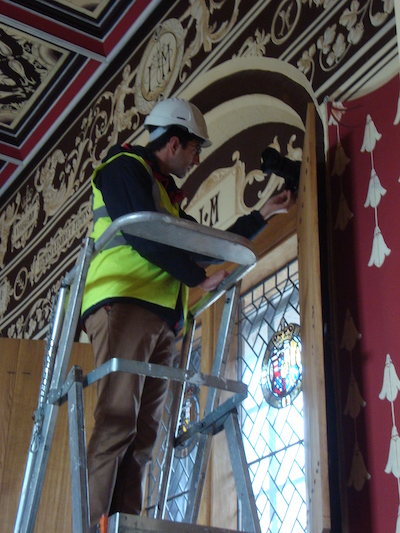
Although there were practical difficulties in keeping the camera and timer running, and maintaining the camera angle, we obtained some useful data. Overall we found that it was possible to capture images which could be interrogated by strain monitoring software with a single camera in this setting.
We also gained interesting insights into the tapestry behaviour. While we would not expect to see any sign of damage after such a short period of display, monitoring showed a sharp increase in strain in the first month of hanging, showing that the tapestry elongated as it was first hung. This was probably mainly due to the yarns un-crimping and straightening under the load. After the initial ‘hanging out’, the tapestry was much more affected by the changing relative humidity (RH), expanding and contracting with RH fluctuations. With this, fatigue is likely to be the dominant mechanism causing damage over the long term, rather than simple static loading by the tapestry’s own weight.
Read more
- Alsayednoor, J., Harrison, P., Dobbie, M., Costantini, R. and Lennard, F. (2019) Evaluating the use of digital image correlation for strain measurement in historic tapestries using representative deformation fields. Strain, 55(2), e12308. (doi: 10.1111/str.12308)
- Alsayednoor, J., Lennard, F., Yu, W.R. and Harrison, P. (2017) Influence of specimen pre-shear and wrinkling on the accuracy of uniaxial bias extension test results. Composites Part A: Applied Science and Manufacturing, 101, pp. 81-97. (doi: 10.1016/j.compositesa.2017.06.006)
Tapestry Display and Slanted Supports
It is now common in mainland Europe to display tapestries on slanted supports – these are boards covered in fabric, tilted at a small angle (often 5° from the vertical), which aim to provide greater support to a fragile historic tapestry on display. However there had been no previous research to quantify the optimum display angle. Our investigation looked at both the degree of slope and the amount of friction provided by commonly used board-covering fabrics - these are often pile fabrics such as brushed cotton domette (also known as molton), velvet and polyester felt.
A simple mathematical calculation demonstrates that a small angle of slope gives a negligible decrease in the load experienced by the tapestry when the support is moved from vertical to the slight angle of 5° from the vertical. A tilt of 45° gives much greater support, but is generally impractical for displaying large tapestries. Tests on model fabrics suspended from a board at different angles provided a visual illustration of this, showing that strain barely decreased with a small degree of slant. However it was clear that increasing friction between the support and the tapestry had a considerable impact.
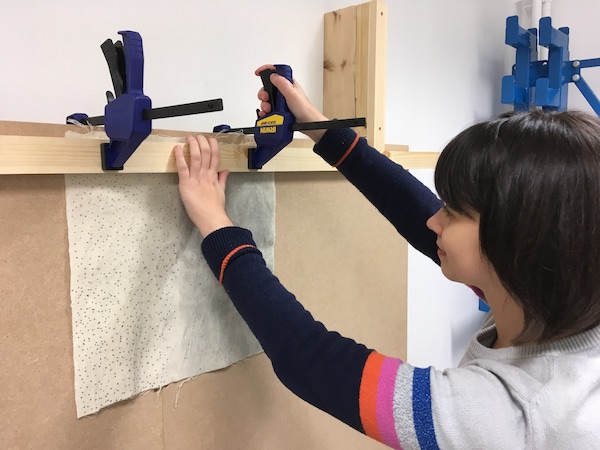
We used a simple inclined plane method to test friction, covering a board with one of the fabrics, placing a tapestry fragment on it, then tilting the board until the tapestry began to slip. Friction with all the fabrics was so high that the board could be tilted beyond vertical, until the tapestry was beginning to face the floor (at around 100° from the vertical, before it began to slip). This made it impossible to calculate a value for the coefficient of friction and so it was clear that the simple Coulomb model of friction does not apply in these cases. Instead it appears that mechanical interlocking between the fibres of the tapestry and the fabric covering generates a ‘mechanical adhesion’ between the fabric surfaces.
We believed that the effect of friction was so great that a covered board would provide good support to a tapestry if it was displayed vertically, with no slant, and this was demonstrated in a trial. A small tapestry was suspended against a vertical board, which was half-covered with a cotton molton fabric.
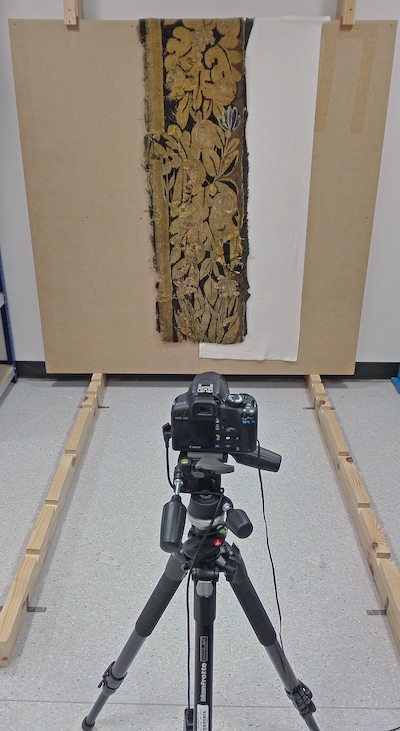
Monitoring with DIC showed that the strain value was low (around 0.01%) in the area with molton, compared with almost 0.05% in the area without the molton board covering. The part of the tapestry on the covered section of the board was less affected by fluctuations in humidity than the tapestry on the uncovered board, indicating that the molton board cover had a stabilising effect, reducing expansion and contraction of the tapestry.
Read more
- Costantini, R., Lennard, F., Alsayednoor, J. and Harrison, P. (2020) Investigating mechanical damage mechanisms of tapestries displayed at different angles using 2D DIC. European Physical Journal Plus, 135, 515. (doi: 10.1140/epjp/s13360-020-00520-7)
- Lennard, F., Costantini, R. and Harrison, P. (2021) Understanding the role of friction and adhesion in the display of tapestries on slanted supports. Studies in Conservation, 66(1), pp. 32-43. (doi: 10.1080/00393630.2020.1761184)
Tapestry Conservation and Stitching Techniques
In the UK it is more common to stitch tapestries onto a support of linen fabric than to display them on fabric-covered boards. A wide variety of stitching methods is used to conserve tapestries around the world, though in the UK it is common to use a technique known as brick couching. This provides intensive stitching, in yarns colour-matched to the tapestry weft, to secure damaged areas to a support fabric. This achieves structural support and the reintegration of the tapestry image simultaneously.
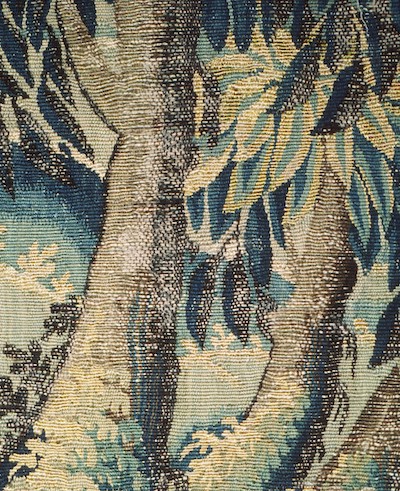
We used DIC monitoring as a means of investigating the effect of different stitching techniques including brick couching and laid couching (used more frequently in mainland Europe), and both full support fabric and support patches. It was proposed that a successful stitched support would allow the tapestry to expand and contract with fluctuations in relative humidity, but would prevent weak and damaged areas from opening up under the tapestry’s weight. Samples of wool rep fabric were used to replicate tapestry for the main trials to ensure comparability. These were artificially damaged to simulate an area of weft loss in a tapestry and rows of brick couching and/or laid couching were worked across the bare warps. In some cases a grid of running stitch support lines was added. The samples were suspended from the upper edge for one week and monitored with 2D DIC. The resulting strain graphs and strain maps gave information on the deformation and the strain (percentage deformation) experienced globally, by the sample overall, and locally, across the area of damage.
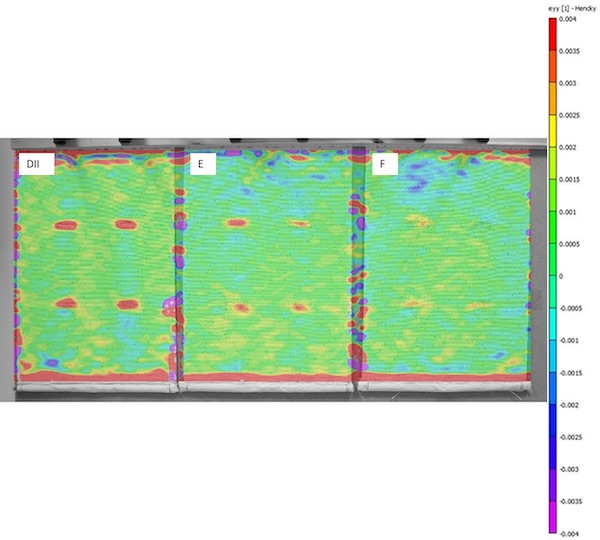
While we could only trial a small number of samples and the tests do not have statistical validity, the conclusions were of interest. The main conclusions were that all forms of stitching greatly reduced the strain across damaged areas, in comparison with the damaged, untreated samples which were used as controls – that is, there was less extension in the damaged areas after they had been supported. As would be expected, the greater the density of stitching, the more the strain across the damaged areas was reduced. However, it was observed that the most dense stitching (lines of stitching at 4mm spacing) reduced the strain across the damaged areas to a lower level than the overall global strain across the whole sample and could be described as ‘too much stitching’. When comparing patched and full supports, it was concluded that a patch gives good support if the ‘tapestry’ is damaged in a discrete area but is basically sound in the surrounding area. If the tapestry is damaged overall, a full support provides better support for weak areas. Strain was noticeably lower in a damaged region if it was encompassed within an overall support structure, even if it was not itself stitched to the support fabric.
A final stage of the testing was carried out on a tapestry fragment and the same behaviour was observed here. The fragment was treated by stitching in two stages: firstly by applying three patches of linen fabric to the back, securing damaged areas with brick couching , and secondly by giving this area an overall support of linen using a grid of running stitch support lines.
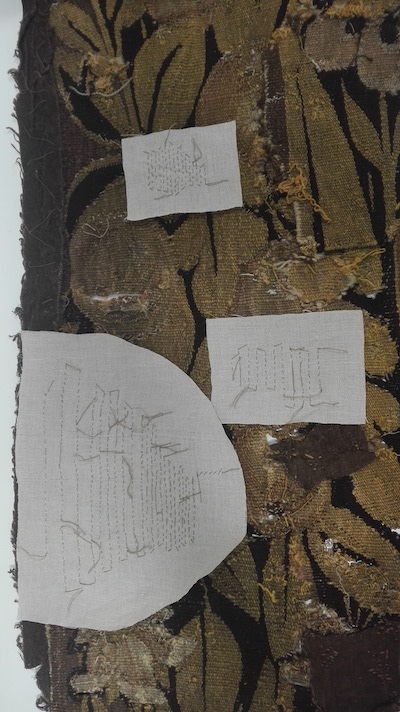
The first stage of treatment showed that extension (or strain) was effectively reduced in the damaged areas that were supported. However further areas of damage between the patches were not supported and showed high strain values. When the additional full support was applied, strain was much lower in the damaged areas that were encompassed by the support fabric; even when they were not stitched to the support fabric directly, the linen gave noticeable support and prevented extension.
Overall we found that, as hoped, DIC was a useful method for assessing the impact of different stitching techniques on the tapestry structure.
Read more
Learn More
Project Publications
Dallal, M. and Lennard, F. (2020-21) La problématique d’accrochage des tapisseries: Recherches en cours. Coré, 1 (Winter 2020-2021).

